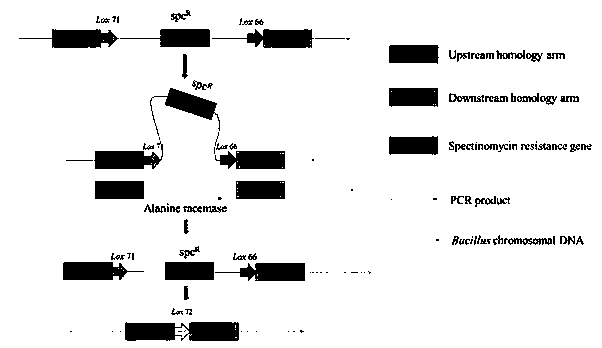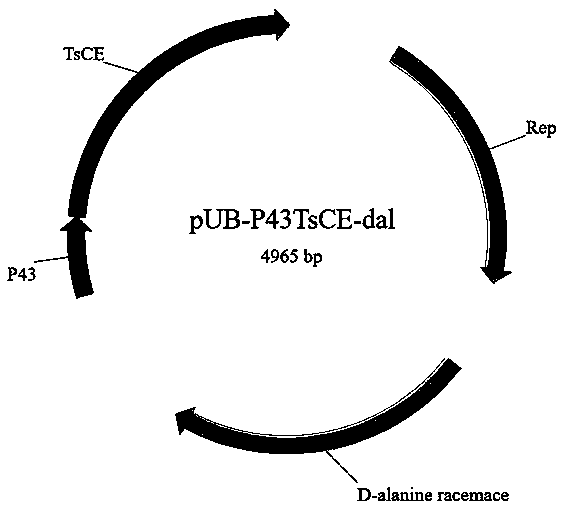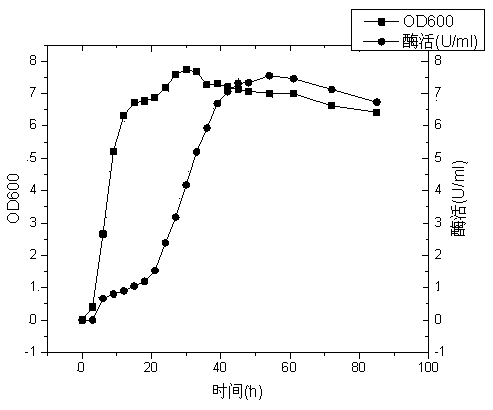Recombinant bacillus subtilis for expressing cellobiose-2-epimerase based on D-alanine defective screening, and construction method of recombinant bacillus subtilis
A technology of Bacillus subtilis and epimerase, applied in the field of genetic engineering of enzymes, can solve the problem of high cost
- Summary
- Abstract
- Description
- Claims
- Application Information
AI Technical Summary
Problems solved by technology
Method used
Image
Examples
Embodiment 1
[0024] Example 1: D-alanine-deficient Bacillus subtilis 1A751 ( dal - ) construction
[0025] Table 1D - Alanine-deficient Bacillus subtilis 1A751 ( dal - ) for the construction of primer pairs
[0026]
[0027] Using the plasmid p7S6 as a template, the primer pair P3 / P4 will lox 71- spc - lox 66 antibiotic resistance gene fragments were amplified and recovered.
[0028] D-alanine racemase gene on chromosome of Bacillus subtilis 1A751 dal The fragments with a length of 800-900bp on both sides were selected as homologous regions, and the homologous regions at both ends were amplified and recovered with primer pairs P1 / P2 and P5 / P6 respectively.
[0029] Use the primer pair P1 / P6 to combine the homology arm fragments at both ends with antibiotics lox 71- spc - lox 66 were fused together by PCR technology.
[0030] PCR reaction system: Add the following reagents in order in 0.2mL PCR tube: 1.5μL each of upstream and downstream primers (P1 / P6); 5μL HusionHFbu...
Embodiment 2
[0035] Example 2: Construction of food-grade safe plasmid pUB-P43-TsCE-dal
[0036] Table 2 Primer pairs required for the construction of food-grade safe plasmid pUB-P43-TsCE-dal
[0037]
[0038] To enhance the expression, a strong promoter P43 was fused upstream of the CE enzyme gene to form a P43-TsCE expression unit. The P43-TsCE fragment was amplified using primer pair P7 / P9. Using pUB110 (NCBI-GeneID: 9507338) as the starting vector, the vector backbone pUB was amplified using the primer pair P8 / P10. The P43-TsCE and pUB fragments were then subjected to PCR to form multimers.
[0039] PCR reaction system: Add the following reagents in sequence to a 0.2 mL PCR tube: 5 μL HusionHFbuffer (5×); 2 μL 10 mMdNTPmix (2.5 mMeach); 2 μL P43-TsCE; 2 μL pUB; 0.5 μL Husion high-fidelity DNA polymerase;
[0040] PCR amplification conditions: pre-denaturation at 98°C for 30s; denaturation at 98°C for 30s, annealing at 55°C for 15s, extension at 72°C for 1min (30 cycles); extensio...
Embodiment 3
[0043] Embodiment 3: the fermentation of recombinant bacterium
[0044] 1. CE enzyme activity assay method: Add 800 μL of 250 mM lactose dissolved in phosphate buffer (50 mM, pH 7.0) to 1 mL of reaction system, 200 μL of fermentation broth, incubate at 65°C for 15 minutes, then add HCl to the final concentration 200mM to stop the enzyme reaction.
[0045] 2. Detect the amount of ipilactose produced by HPLC, and calculate the enzyme activity. Enzyme activity unit (U): The amount of enzyme required to catalyze the production of 1 μmol of pilactose per minute.
[0046] 3. Use an inoculation loop to pick fresh colonies from the plate and inoculate them into the seed medium, culture at 37°C, 200rpm, for 12-14 hours. Inoculate into the fermentation medium with 3% inoculum amount, 37°C, 200rpm, and take samples regularly to measure OD 600 , enzyme activity data ( image 3 ).
[0047] Seed medium: tryptone (10g / L), yeast extract (5g / L), NaCl (10g / L), prepared with double distille...
PUM
 Login to View More
Login to View More Abstract
Description
Claims
Application Information
 Login to View More
Login to View More - R&D
- Intellectual Property
- Life Sciences
- Materials
- Tech Scout
- Unparalleled Data Quality
- Higher Quality Content
- 60% Fewer Hallucinations
Browse by: Latest US Patents, China's latest patents, Technical Efficacy Thesaurus, Application Domain, Technology Topic, Popular Technical Reports.
© 2025 PatSnap. All rights reserved.Legal|Privacy policy|Modern Slavery Act Transparency Statement|Sitemap|About US| Contact US: help@patsnap.com



